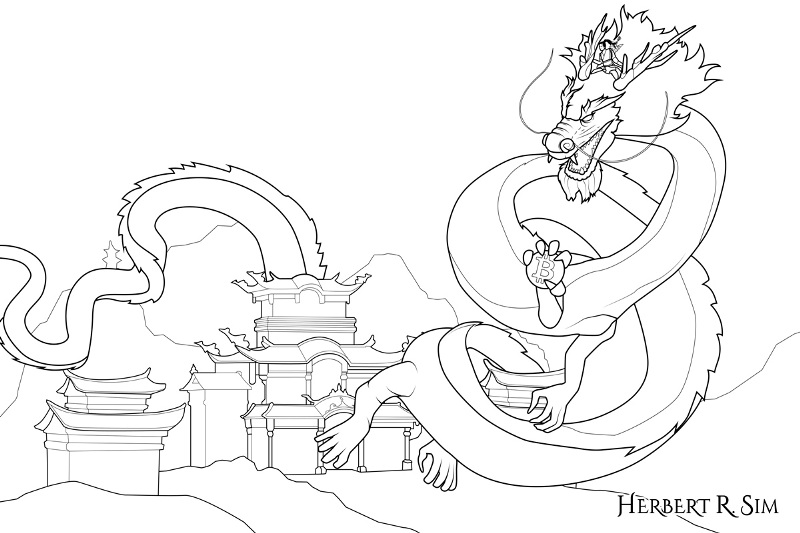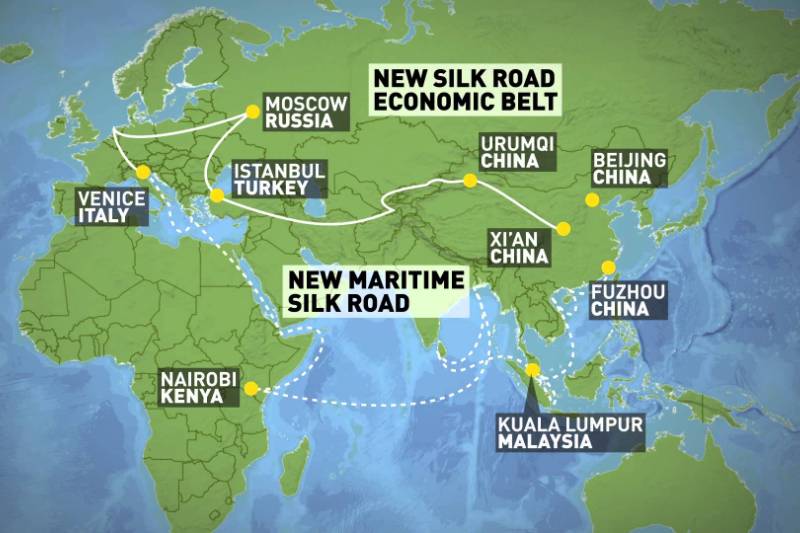
I illustrated the above sketch showcasing the legendary Chinese Dragon, in ancient China, grasping a Bitcoin crystal ball in its claws.
—————————————————
The Belt and Road Initiative (BRI) a global development strategy adopted by the Chinese government involving infrastructure development and investments in 152 countries and international organizations in Asia, Europe, Africa, the Middle East, and the Americas; is designed specifically to reignite the economic and trade connections within the landlocked Eurasian continent and to spread the momentum of development from the maritime Asia Pacific region into the mainland.
There are specific concerns related to the debt-trap possibilities, the lack of trusted financial institutions, technological shortfalls and the absence of trained technical talent in the Central Asian states where the roll out of investment is set to begin.
Before any of the development magic can occur, these are major discrepancies that have to be over-come and what are the areas in which cryptocurrencies can aid to overcome issues?
Human Resource (HR)
The BRI is designed to channel necessary talent and lifeblood into the developing economies of Eurasia, traditionally locked away from the major international talent hubs in Asia and Europe. The dearth of talent is a ‘wicked problem’ in the sense that despite overwhelming demand, there remains a lack of people willing to relocate to developing regions that are not covered by international financial, insurance, HSE (Health, Safety and Environment) and technological services. The lack of qualified people on the ground, forces companies to outsource or to base separate in traditional hubs and then development is hampered on the ground.
The blockchain information storage system which decentralizes transaction and employment histories across a web of storage bases, essentially atomizes talent search. There is a considerable amount of HR industry destination prejudice, path dependencies and database institutional barriers of entry to international talent, especially for fresh locations in Central Asia.
Block-chain has the potential to tear through all of that simply by directly linking employers with necessary talent and eliminating the middle men. In grassroots industry sectors like Construction, Infrastructure and Utilities, this will be crucial in eliminating the unnecessary barriers between multiple parties; given that the potential employer can access the employment and skills history of required talents through the blockchain contracts history.

As you can see from my Work-In-Progress, the revisions I made to the claws, adding long talons. And finally coloring in the illustration in full. And of course featuring ‘The Bitcoin Man‘, with his legendary ‘Blade of Bitcoin‘.
—————————————————
Financial Risk
Payment systems and HR payroll accounting, is one of those unspoken difficulties linked to working in raw locations within booming capitals like Dushanbe, Tashkent, Astana etc. How to secure the necessary forex risk, account for HSE costs, insurance premiums etc, is relegated to major human resource consultancies and first world banking systems, with a hefty cost attributed to these parties.
Once again, Block-chain techniques can be used in conjunction with crypto-currencies to shave off the middle-men, smooth over forex risks and create a self-regulating ledger of transactions. The blockchain paradigm verifies and automates the flow of information and shifts the power of accessing and evaluating financial data to the users; this is the reason it’s being pursued aggressively by investment banks, the disruptive potential is too potent to ignore.
The automated transaction, employment and skills acquisition ledger of blockchain systems, will also make tax transfer and payment a much easier task for OECD employees in distant locations along the BRI boom economies. For instance, a highway construction project that requires the employment of a range of OECD staff from Italy, France, Japan, the US etc, would typically translate intoY a tax consultancy nightmare that imposes financial penalties on the construction firm.
It also translates into a legal regulatory nightmare for developing countries with precious manpower resources to spare. Blockchain has the potential to merge these multiple systems into a distributed international network with crypto-grade security. Of course cybersecurity concerns are typically relegated to users and it’s the responsibility of individual firms, domestic HR and local employees to ensure data fidelity, but at least the macro-level costs and institutional barriers can be streamlined.
Tax evasion and compliance in third world locations, is a perennial headache for employers, revenue authorities and HR alike; a blockchain system is not going to deter determined tax dodgers but it will make the regulatory oversight and compliance measures much more efficient. It would be much harder for dodgers to utilize existing loopholes and lack of jurisdiction collaboration simply as the automated ledgers compute all transactions the minute they’re generated.
—————————————————

(Photo: CCTV/MediaLink via University of Oxford, The Faculty of Law)
—————————————————
Information management, legal conundrums and infrastructure construction- the BRI
A baseline visualization of potential problems in the BRI countries, would be the problem of organization, management and coordination between multiple MNCs, grassroots firms and government bodies with no experience of collaboration. The highspeed rail projects currently racing through Central Asia is a prime example; typically European construction majors are bidding for Chinese funding, with Uzbek, Kazakh, Tajik government bodies.
The language coordination problem itself is a potential nightmare, let alone the reality when shovels hit the ground. Under these circumstances, relying on quantitative data coordination through block-chain becomes an organizational necessity, rather than a fad. In situations where millimetre construction flaws become fatal to the safety of crew or the viability of billion dollar projects, cultural and management quirks are no longer quaint.
One of blockchains potential ‘threats’ to traditional corporate hierarchies, is its decentralized and ‘flat’ information sharing structure; this can be antithetical to traditional construction concerns that thrive on a more hegemonic command structure. So as in nearly all technological adaptation problems, the key lies in indigenous corporate culture and the command structure of information sharing.
In the BRI today, there is a growing clash between several corporate cultures; authoritarian Chinese financial capital, OECD construction firms and state-owned infrastructure giants from Asia, indigenous Eurasian grassroots contractors etc. Finding a common command language that bypasses information asymmetry problems, is becoming an absolute necessity.
There is a running online joke that blockchain is basically a faddish reinvention of the old-fashioned accounting ledger; it’s not wrong but it’s shaping up to be much more than that. In a competitive and culturally charged environment like the infrastructure sector, blockchain provides a neutral platform for info-management across all building lifecycles. It is simply a centralized framework that creates an open ledger, especially when legal liabilities are prone to occur.
In a high technology environment, where sensor equipment determines objective construction planning, block-chain also secures facilities from the possibility of info-theft or manipulation. In remote and regulation-sparse jurisdictions across the BRI spectrum of markets, this trustworthiness is almost essential for multiple parties to collaborate.
Conclusion
Human Resource Management, Taxation woes and the multi-dimensional problems of coordinating a series of different players into intricate projects can all be smoothened by a smart combination of crypto-currencies, blockchain techniques and careful governance. The BRI is a frontier for all forms of new endeavours and its possible that a grassroots effort to weave them together, would create something new under the sun.
—————————————————

